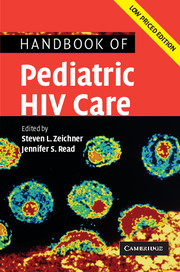Book contents
- Frontmatter
- Contents
- List of contributors
- List of abbreviations
- Foreword
- Preface
- Part I Scientific basis of pediatric HIV care
- Part II General issues in the care of pediatric HIV patients
- Part III Antiretroviral therapy
- Part IV Clinical manifestations of HIV infection in children
- 18 Cutaneous diseases
- 19 Neurologic problems
- 20 Ophthalmic problems
- 21 Oral health and dental problems
- 22 Otitis media and sinusitis
- 23 Cardiac problems
- 24 Pulmonary problems
- 25 Hematologic problems
- 26 Gastrointestinal disorders
- 27 Renal disease
- 28 Endocrine disorders
- 29 Neoplastic disease in pediatric HIV infection
- Part V Infectious problems in pediatric HIV disease
- Part VI Medical, social, and legal issues
- Appendix 1 Formulary of antiretroviral agents
- Appendix 2 National Institutes of Health sponsored clinical trials for pediatric HIV disease
- Appendix 3 Selected HIV-related internet resources
- Appendix 4 Selected legal resources for HIV-infected children
- Index
- References
20 - Ophthalmic problems
Published online by Cambridge University Press: 23 December 2009
- Frontmatter
- Contents
- List of contributors
- List of abbreviations
- Foreword
- Preface
- Part I Scientific basis of pediatric HIV care
- Part II General issues in the care of pediatric HIV patients
- Part III Antiretroviral therapy
- Part IV Clinical manifestations of HIV infection in children
- 18 Cutaneous diseases
- 19 Neurologic problems
- 20 Ophthalmic problems
- 21 Oral health and dental problems
- 22 Otitis media and sinusitis
- 23 Cardiac problems
- 24 Pulmonary problems
- 25 Hematologic problems
- 26 Gastrointestinal disorders
- 27 Renal disease
- 28 Endocrine disorders
- 29 Neoplastic disease in pediatric HIV infection
- Part V Infectious problems in pediatric HIV disease
- Part VI Medical, social, and legal issues
- Appendix 1 Formulary of antiretroviral agents
- Appendix 2 National Institutes of Health sponsored clinical trials for pediatric HIV disease
- Appendix 3 Selected HIV-related internet resources
- Appendix 4 Selected legal resources for HIV-infected children
- Index
- References
Summary
Introduction
Ophthalmic disease is common in patients with HIV infection, occurring in up to 75% of patients over the course of their illness [1]. As in other organ systems, a hallmark of the ocular sequelae of HIV infection is the presence of opportunistic infections by bacteria, viruses, fungi, and parasites, which may occur in up to 30% of HIV-positive individuals [2, 3]. HIV-positive children may acquire infections that are also common in immunocompetent patients, although the severity is often greatly increased.
Because children rarely complain of ocular symptoms, eye disease such as cytomegalovirus (CMV) retinitis, is often diagnosed at a more advanced stage. This chapter gives an overview of the ocular manifestations of HIV in children.
Epidemiology
Ophthalmologic disease in HIV-infected children can involve any part of the eye. The ocular manifestations of HIV infection in children are listed in Table 20.1; few of the disorders occur in more than 5% of children. The most common ophthalmologic diseases in HIV-infected children affect the posterior segment (vitreous, retina, and choroid).
Clinical examination
Routine screening eye examinations are suggested because sight-threatening complications like CMV retinitis can be asymptomatic, and early diagnosis and treatment can prevent loss of sight. Sight-threatening diseases occur most frequently in children with advanced HIV infection and low CD4+ lymphocyte counts. Regular screening examinations should be performed by an experienced ophthalmologist according to Table 20.2 [4].
- Type
- Chapter
- Information
- Handbook of Pediatric HIV Care , pp. 520 - 534Publisher: Cambridge University PressPrint publication year: 2006



